 | | | Switch to: Europe, USA, New Zealand, Antarctica Credit: NOAA/Ovation  Planetary K-index Planetary K-index
Now: Kp= 1 quiet
24-hr max: Kp= 2 quiet
explanation | more data
Interplanetary Mag. Field
Btotal: 6.3 nT
Bz: 3.9 nT north
more data: ACE, DSCOVR
Updated: Today at 2346 UT  Coronal Holes: 01 May 17 Coronal Holes: 01 May 17 
There are no large coronal holes on the Earth side of the sun. Credit: NASA/SDO.  Noctilucent Clouds The southern season for noctilucent clouds began on Nov. 17, 2016. Come back to this spot every day to see the "daily daisy" from NASA's AIM spacecraft, which is monitoring the dance of electric-blue around the Antarctic Circle. Switch view: Ross Ice Shelf, Antarctic Peninsula, East Antarctica, Polar Updated at: 02-24-2017 17:55:02 Noctilucent Clouds The southern season for noctilucent clouds began on Nov. 17, 2016. Come back to this spot every day to see the "daily daisy" from NASA's AIM spacecraft, which is monitoring the dance of electric-blue around the Antarctic Circle. Switch view: Ross Ice Shelf, Antarctic Peninsula, East Antarctica, Polar Updated at: 02-24-2017 17:55:02  SPACE WEATHER
NOAA Forecasts | | Updated at: 2017 May 01 2200 UTC FLARE | 0-24 hr | 24-48 hr | CLASS M | 01 % | 01 % | CLASS X | 01 % | 01 % |  Geomagnetic Storms: Geomagnetic Storms:
Probabilities for significant disturbances in Earth's magnetic field are given for three activity levels: active, minor storm, severe storm Updated at: 2017 May 01 2200 UTC Mid-latitudes | 0-24 hr | 24-48 hr | ACTIVE | 15 % | 30 % | MINOR | 05 % | 10 % | SEVERE | 01 % | 01 % | High latitudes | 0-24 hr | 24-48 hr | ACTIVE | 15 % | 15 % | MINOR | 25 % | 30 % | SEVERE | 20 % | 40 % | | | |  | | | | | | | | | | | Lights Over lapland is excited to announce that Autumn Aurora Adventures are available for immediate booking! Reserve your adventure of a lifetime in Abisko National Park, Sweden today! | | | MAGNETIC STORM POSSIBLE THIS WEEK: A filament of magnetism on the sun exploded yesterday (April 30th), hurling a CME into space. NOAA analysts say the cloud could deliver a glancing blow to Earth's magnetic field on May 3rd with a 40% chance of ensuing minor geomagnetic storms. High-latitude sky watchers should be alert for auroras, especially in the southern hemisphere where darkening autumn skies favor visibility. Free: Aurora Alerts METEORS FROM HALLEY'S COMET: According to Canada's Meteor Orbit Radar (CMOR), a "hot spot" has appeared in the constellation Aquarius. This is a sign that the annual eta Aquarid meteor shower (ETA) is underway. This sky map shows where the radar is detecting pings from incoming meteors in broad daylight on May 1st: 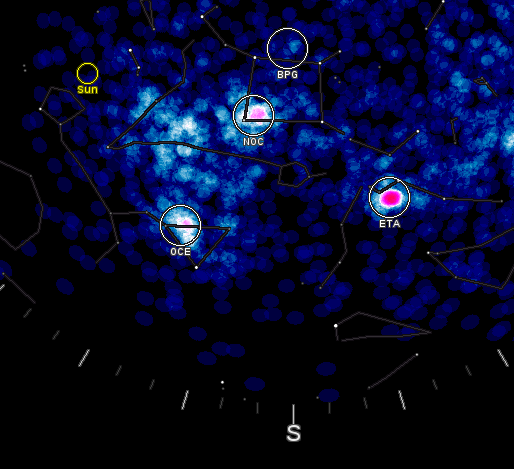
These meteors are pieces of Halley's Comet, hitting Earth's atmosphere at 66 km/s and disintegrating ~100 km above Earth's surface. During the next week our planet will be crossing a network of debris streams from the comet, producing a drizzle of eta Aquarids numbering 10 to 30 per hour in the northern hemisphere and twice that number in the southern hemisphere.
Two leading meteor forecasters have noted the possibility of eta Aquarid outbursts in the days ahead. Mikhail Maslov says meteor activity could increase on May 4th (14h- 18h UT) when Earth grazes a dust trail released by Comet Halley in the year -616. Forecaster Mikiya Sato agrees that that Earth could encounter the -616 dust trail, but later on May 5th (05h - 15h UT), possibly with such a gentle graze that no special increase is detectable. In most years the strongest activity is seen around May 6th, which may still prove true in 2017.
The best time to look, no matter where you live, is during the dark hours just before dawn when the constellation Aquarius is rising in the east. Monitor the meteor gallery for sightings. Realtime Space Weather Photo Gallery THESE PENDANTS HAVE TOUCHED SPACE: These pendants have touched space--and returned to Earth in time for Mother's Day. To support their cosmic ray monitoring program, the students of Earth to Sky Calculus flew a payload-full of jewelry to the stratosphere onboard a high-altitude helium balloon. Here's one of the pendants 113,200 feet above the Sierras of central California: 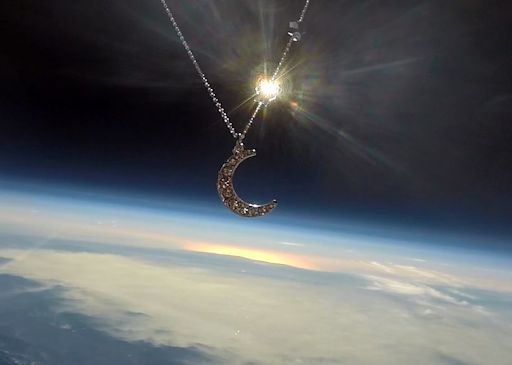
These necklaces make great Mother's Day gifts--and you have have one for $89.95. Each glittering pendant comes with a greeting card showing the jewelry in flight and telling the story of its journey to the stratosphere and back again. More far-out Mother's Day gifts may be found in the Earth to Sky Store. All proceeds support atmospheric radiation monitoring and hands-on STEM education. Realtime Space Weather Photo Gallery RARE BLUE AURORAS: Northern Lights are usually green, and sometimes red. Those are the colors produced by oxygen when it is excited by electrons raining down from space. On April 22nd, Didier Lindsey of Fox, Alaska, witnessed an apparition of aurora-blue: 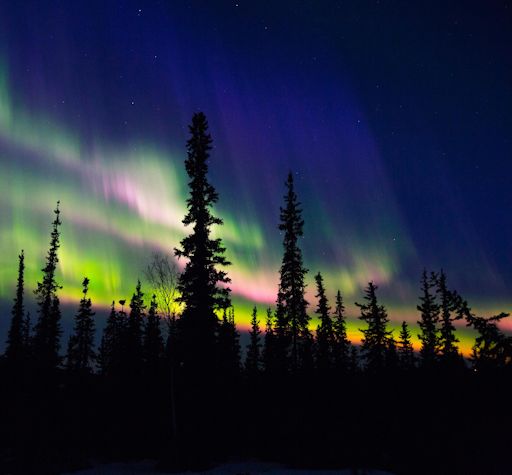
Hours before he took the picture, a CME struck Earth's magnetic field, igniting a G2-class geomagnetic storm. "The sky filled with very active auroras," Lindsey says,"including these rare blues." In auroras, blue is a sign of nitrogen. Energetic particles striking ionized molecular nitrogen (N2+) at very high altitudes produces a cold azure glow of the type captured in Lindsey's photo. Why it rivaled the usual hues of oxygen on April 22nd is unknown. Auroras still have the capacity to surprise.
Any auroras tonight, blue or otherwise, would be a surprise. Geomagnetic conditions are quiet as the solar wind relaxes into a steady breeze of low-speed plasma. NOAA forecasters estimate a scant 10% chance of polar geomagnetic storms on April 29th. Realtime Aurora Photo Gallery
Realtime Comet Photo Gallery Every night, a network of NASA all-sky cameras scans the skies above the United States for meteoritic fireballs. Automated software maintained by NASA's Meteoroid Environment Office calculates their orbits, velocity, penetration depth in Earth's atmosphere and many other characteristics. Daily results are presented here on Spaceweather.com. On May. 1, 2017, the network reported 0 fireballs.
(0 sporadics)  In this diagram of the inner solar system, all of the fireball orbits intersect at a single point--Earth. The orbits are color-coded by velocity, from slow (red) to fast (blue). [Larger image] [movies] Potentially Hazardous Asteroids ( PHAs) are space rocks larger than approximately 100m that can come closer to Earth than 0.05 AU. None of the known PHAs is on a collision course with our planet, although astronomers are finding new ones all the time. On May 1, 2017 there were 1799 potentially hazardous asteroids.  | Recent & Upcoming Earth-asteroid encounters: | Asteroid | Date(UT) | Miss Distance | Velocity (km/s) | Diameter (m) | | 2017 HW2 | 2017-Apr-27 | 9.2 LD | 9.1 | 18 | | 2017 FE157 | 2017-Apr-29 | 18.4 LD | 8.6 | 63 | | 2017 HK1 | 2017-May-05 | 16.9 LD | 2.6 | 38 | | 2015 VD1 | 2017-May-07 | 18.2 LD | 10.5 | 34 | | 2012 EC | 2017-May-16 | 19.5 LD | 4.5 | 74 | | 2017 CS | 2017-May-29 | 8 LD | 9.1 | 468 | | 418094 | 2017-Jun-01 | 8 LD | 23.2 | 490 | | 2010 VB1 | 2017-Jun-16 | 10.3 LD | 8.3 | 81 | | 471984 | 2017-Jun-18 | 19.1 LD | 7.7 | 102 | Notes: LD means "Lunar Distance." 1 LD = 384,401 km, the distance between Earth and the Moon. 1 LD also equals 0.00256 AU. MAG is the visual magnitude of the asteroid on the date of closest approach. | | Cosmic Rays in the Atmosphere |
Readers, thank you for your patience while we continue to develop this new section of Spaceweather.com. We've been working to streamline our data reduction, allowing us to post results from balloon flights much more rapidly, and we have developed a new data product, shown here: 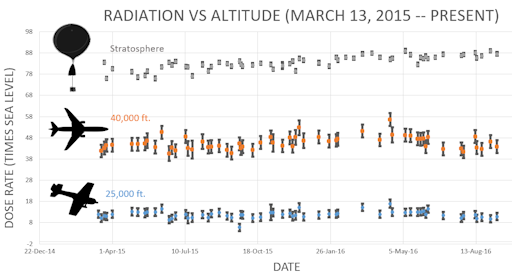
This plot displays radiation measurements not only in the stratosphere, but also at aviation altitudes. Dose rates are expessed as multiples of sea level. For instance, we see that boarding a plane that flies at 25,000 feet exposes passengers to dose rates ~10x higher than sea level. At 40,000 feet, the multiplier is closer to 50x. These measurements are made by our usual cosmic ray payload as it passes through aviation altitudes en route to the stratosphere over California. What is this all about? Approximately once a week, Spaceweather.com and the students of Earth to Sky Calculus fly space weather balloons to the stratosphere over California. These balloons are equipped with radiation sensors that detect cosmic rays, a surprisingly "down to Earth" form of space weather. Cosmic rays can seed clouds, trigger lightning, and penetrate commercial airplanes. Furthermore, there are studies ( #1, #2, #3, #4) linking cosmic rays with cardiac arrhythmias and sudden cardiac death in the general population. Our latest measurements show that cosmic rays are intensifying, with an increase of more than 12% since 2015: 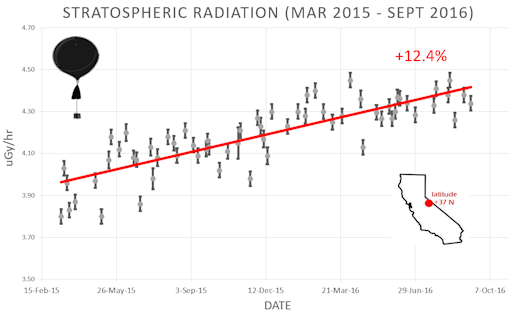
Why are cosmic rays intensifying? The main reason is the sun. Solar storm clouds such as coronal mass ejections (CMEs) sweep aside cosmic rays when they pass by Earth. During Solar Maximum, CMEs are abundant and cosmic rays are held at bay. Now, however, the solar cycle is swinging toward Solar Minimum, allowing cosmic rays to return. Another reason could be the weakening of Earth's magnetic field, which helps protect us from deep-space radiation. The radiation sensors onboard our helium balloons detect X-rays and gamma-rays in the energy range 10 keV to 20 MeV. These energies span the range of medical X-ray machines and airport security scanners. The data points in the graph above correspond to the peak of the Reneger-Pfotzer maximum, which lies about 67,000 feet above central California. When cosmic rays crash into Earth's atmosphere, they produce a spray of secondary particles that is most intense at the entrance to the stratosphere. Physicists Eric Reneger and Georg Pfotzer discovered the maximum using balloons in the 1930s and it is what we are measuring today. | | The official U.S. government space weather bureau | | | The first place to look for information about sundogs, pillars, rainbows and related phenomena. | | | Researchers call it a "Hubble for the sun." SDO is the most advanced solar observatory ever. | | | 3D views of the sun from NASA's Solar and Terrestrial Relations Observatory | | | Realtime and archival images of the Sun from SOHO. | | | from the NOAA Space Environment Center | | | a proud supporter of science education and Spaceweather.com | | | fun to read, but should be taken with a grain of salt! Forecasts looking ahead more than a few days are often wrong. | | | from the NOAA Space Environment Center | | | the underlying science of space weather |  | Beautyz for top beauty products reviews and their buying guides |  | Reviews here can help you to pick up best memory foam mattresses. | | | These links help Spaceweather.com stay online. Thank you to our supporters! | | | | | | | | |  | |  |   | ©2016 Spaceweather.com. All rights reserved. This site is penned daily by Dr. Tony Phillips. | |

